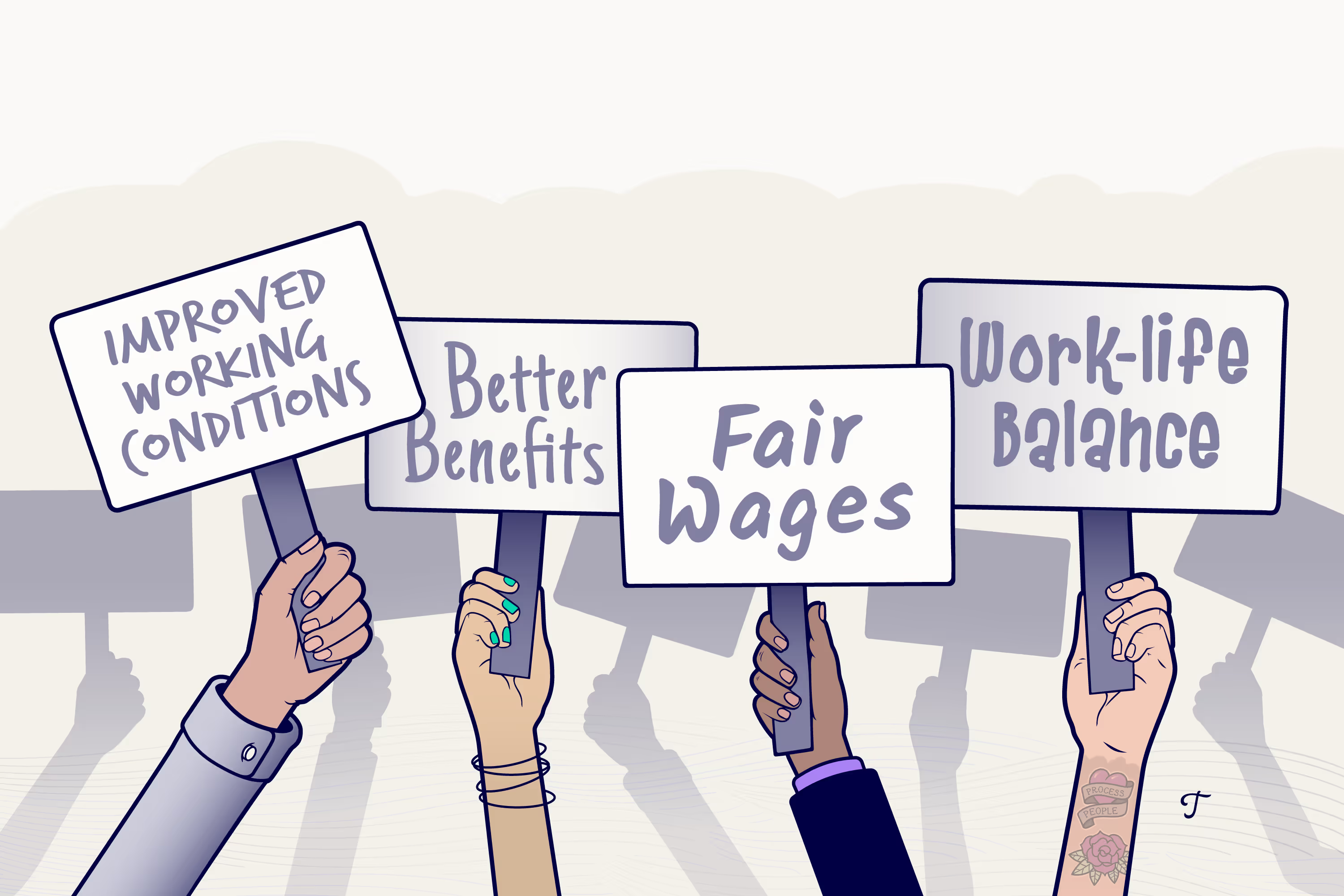
Articles
Why Employees Unionize and What SMBs Can Learn From It
June 20, 2022

Twenty-eight quality assurance (QA) testers recently won their bid for an employee union at the Activision Blizzard subsidiary Raven Software. And they’re not alone — because Amazon, Starbucks, and Etsy have also faced recent unionization efforts.
Employee unions aren’t new, but they haven’t typically existed for massive technology and service companies. So, why the recent urge to unionize? And what can SMBs learn from it?
Let’s find out.
Why are big-company employees unionizing?
The pandemic caused employees to rethink their work situation, and many chose to leave and find jobs elsewhere. This has led to a tightened labor market and increased wages. And experts suspect that employees are leveraging that upper hand to push for unions.
Every union has unique demands. But, in general, these big-company employees want job security, better pay, and improved working conditions.
For example, union efforts began at Raven Software after the company fired 12 QA consultants. It’s also happening amidst a Microsoft deal to acquire Activision for nearly $69 billion, which might explain why the dismissals triggered employees. Plus, one QA tester who voted for unionization cited “better wages, benefits, and work-life balance” as the primary reasons behind their decision.
On April 1, the first Amazon Labor Union (ALU) won its historic vote in New York. And they’re attempting to unionize the warehouses in Staten Island and Bessemer, Alabama. The group seeks longer breaks, paid time off for injuries, and increased hourly pay from $18 to $30.

Starbucks employees are also jumping aboard the unionization train. So far, 130 stores in 26 states have petitioned for one, seeking better pay and hours, safer working conditions, and a direct line into management.
As for Etsy, it’s not employees who are not attempting to unionize, but rather the independent sellers who market and sell products on the platform. And what initially started as a “seller strike” has now evolved into unionizing efforts to convince Etsy to cancel its 30% hike in transaction fees.
What can SMBs learn from the recent urge to unionize?
Unions can form within any business, as there’s no minimum size or required industry to petition for a bid. But as a business leader, you can minimize the potential for unions by learning from these companies’ mistakes:
1. Put your people first.
Employees typically start unionizing because they feel the company is neglecting their needs. But if you proactively put your people first, you can ensure your team is taken care of and supported.
For example, you should have fair and consistent processes and policies that support your employees’ success, including:
- An employee benefits policy explaining compensation and health coverage.
- Health and safety protocols that protect employees and their best interests.
- An open-door policy that allows employees to approach any manager with feedback.
You should also consider how your leadership team’s actions affect frontline employees and their livelihoods. For instance, when Kellogg’s decided to implement a two-tier benefits system that paid new team members at a lower scale than "legacy" employees, workers held a strike.
2. Give your employees a voice.
Unions allow employees to be heard and establish a direct line for bargaining with leadership. But if you already give your employees a voice at work, it can minimize the need for unions.
The open-door policy will allow employees to share their thoughts with management. And when you regularly check in with your team — whether through one-on-one meetings or casual conversations — you can spot issues before they spread quickly.

3. Give everyone a fair share.
According to a Bloomberg study, the typical CEO working for one of the 1,000 biggest U.S. publicly-traded companies gets 144 times more compensation than their median employee. And it’s a big reason why big-tech employees feel exploited and want better pay.
SMBs can learn from this mistake by offering competitive pay and benefits while keeping track of hierarchical income. And when you see a widening pay gap, consider shifting pay structures to fairly compensate all employees for what they contribute to the company.
4. Recognize and respect employees.
When employees feel undervalued and disrespected, it can spark intentions to unionize. But when companies intentionally recognize and respect employees for their contributions, it lessens the likelihood that employees form unions.
For instance, it might be something as small as publicly thanking employees for their efforts. Or it could be something as significant as offering profit sharing, professional development, bonus structures, or even extra vacation time.
5. Don’t interfere with the unionization process.
SMBs can do their best to support their team and prevent unions. But once employees begin the unionization process, businesses can no longer interfere according to The National Labors Act.
Despite it being an unfair and unlawful labor practice, officials have accused Raven Software of threatening unionizing employees with a strict social media policy. And at Amazon, two employees tied to organizing efforts in Staten Island were fired (the repercussions are still unknown).
If your SMB ever faces unionization efforts, the business leaders must address and embrace the stance to move forward. And if anyone inside the organization tries to halt union efforts, it might result in enormous monetary penalties.
It’s scary for any SMB owner to think about unions. But on the bright side, employee unions could provide better business opportunities. Because while your labor costs might go up, you also gain a whole new target market: the union and its supporters.
Similar Blog Posts










